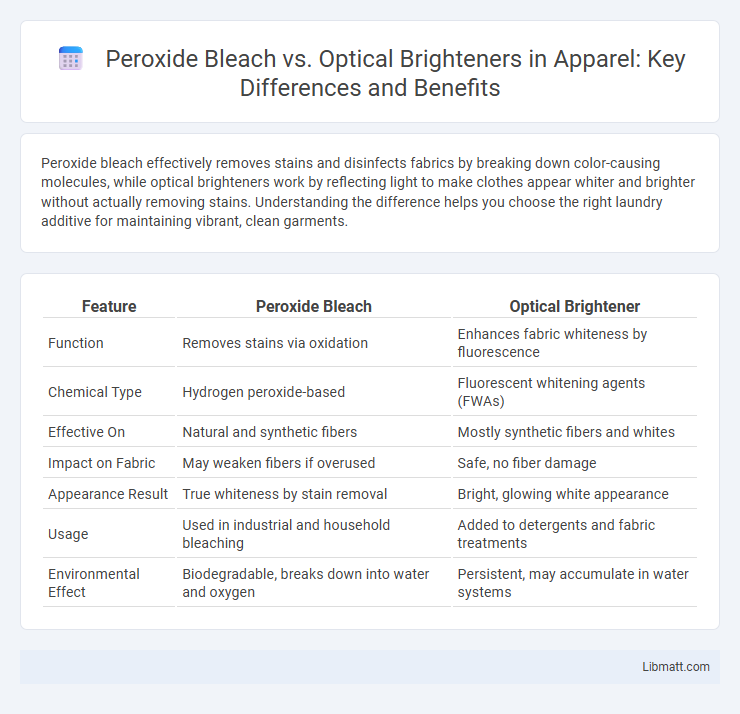Peroxide bleach effectively removes stains and disinfects fabrics by breaking down color-causing molecules, while optical brighteners work by reflecting light to make clothes appear whiter and brighter without actually removing stains. Understanding the difference helps you choose the right laundry additive for maintaining vibrant, clean garments.
Table of Comparison
| Feature | Peroxide Bleach | Optical Brightener |
|---|---|---|
| Function | Removes stains via oxidation | Enhances fabric whiteness by fluorescence |
| Chemical Type | Hydrogen peroxide-based | Fluorescent whitening agents (FWAs) |
| Effective On | Natural and synthetic fibers | Mostly synthetic fibers and whites |
| Impact on Fabric | May weaken fibers if overused | Safe, no fiber damage |
| Appearance Result | True whiteness by stain removal | Bright, glowing white appearance |
| Usage | Used in industrial and household bleaching | Added to detergents and fabric treatments |
| Environmental Effect | Biodegradable, breaks down into water and oxygen | Persistent, may accumulate in water systems |
Introduction to Peroxide Bleach and Optical Brightener
Peroxide bleach is a powerful oxidizing agent that removes stains by breaking down color-causing molecules, making it effective for whitening fabrics and cleaning surfaces. Optical brighteners are chemical compounds that absorb ultraviolet light and re-emit it as visible blue light, enhancing the appearance of whiteness and brightness without actual stain removal. Understanding the difference helps you choose the right product for maintaining fabric brightness or achieving deeper stain removal.
Chemical Composition and Mechanism of Action
Peroxide bleach contains hydrogen peroxide or sodium percarbonate that breaks down stains through oxidation, effectively removing organic compounds by releasing oxygen radicals. Optical brighteners are fluorescent agents composed of stilbene derivatives that absorb ultraviolet light and re-emit it as visible blue light, enhancing fabric whiteness by masking yellowing rather than removing stains. Your choice between peroxide bleach and optical brighteners depends on whether you prefer chemical stain removal or a visual brightening effect without chemical alteration.
Whitening Effect: How Each Method Works
Peroxide bleach whitens fabrics by breaking down colored molecules through oxidation, effectively removing stains and deep-set discoloration. Optical brighteners work by absorbing ultraviolet light and re-emitting it as visible blue light, creating a temporary illusion of whiter garments without altering the fabric's actual color. While peroxide bleach chemically changes the fabric's appearance, optical brighteners enhance perceived whiteness through light reflection.
Application in Laundry and Textile Industries
Peroxide bleach is widely used in the laundry and textile industries for its strong oxidation properties, effectively removing stains and brightening fabrics without damaging fibers. Optical brighteners, on the other hand, work by absorbing ultraviolet light and re-emitting it as visible blue light, enhancing the whiteness and brightness of textiles without altering their chemical structure. Your choice between peroxide bleach and optical brighteners depends on the desired cleaning power and the type of fabric being treated.
Safety and Environmental Impact
Peroxide bleach decomposes into water and oxygen, making it an eco-friendly option with low toxicity and minimal environmental impact. Optical brighteners are synthetic chemicals that can accumulate in water systems, posing potential risks to aquatic life and causing long-term pollution. Safety-wise, peroxide bleach is less likely to cause skin irritation or allergic reactions compared to optical brighteners, which may trigger sensitivities in some individuals.
Advantages of Peroxide Bleach
Peroxide bleach offers powerful stain removal through oxidative reactions that effectively break down organic compounds without damaging fabric fibers. It is environmentally friendly, decomposing into water and oxygen, which reduces chemical residues and pollution compared to optical brighteners that rely on fluorescence. Peroxide bleach enhances fabric whiteness while maintaining colorfastness, making it ideal for sensitive textiles and sustainable laundering practices.
Benefits of Optical Brighteners
Optical brighteners enhance fabric appearance by absorbing ultraviolet light and emitting visible blue light, making whites and colors appear brighter and more vibrant. Unlike peroxide bleach, which chemically breaks down stains, optical brighteners work by improving perceived whiteness without damaging fibers, preserving fabric quality over time. Their ability to boost brightness without harsh chemicals makes them ideal for delicate fabrics and color-safe laundry products.
Limitations and Drawbacks of Both Agents
Peroxide bleach can cause fabric weakening and color fading with repeated use, limiting its application on delicate textiles. Optical brighteners may build up on fabrics over time, leading to dullness and potential skin irritation for sensitive individuals. Your choice between these agents should weigh the trade-off between the cleaning power of peroxide and the cosmetic enhancement of optical brighteners, considering fabric type and sensitivity.
Consumer Preferences and Market Trends
Consumers increasingly prefer peroxide bleach due to its eco-friendly, non-toxic properties and effective stain removal, aligning with the rising demand for sustainable cleaning products. Optical brighteners remain popular for enhancing fabric whiteness and brightness, especially in laundry detergents targeting appearance-conscious shoppers. Market trends show a growing shift towards peroxide-based solutions as awareness of chemical residues and environmental impact influences purchasing decisions worldwide.
Choosing the Right Whitening Solution
Peroxide bleach effectively removes stains and disinfects fabrics by breaking down organic compounds, making it ideal for heavy-duty whitening tasks. Optical brighteners work by absorbing ultraviolet light and re-emitting it as visible blue light, enhancing the appearance of whiteness without altering the fabric itself. Selecting the right whitening solution depends on fabric type, stain severity, and desired brightness durability, with peroxide bleach suited for deep cleaning and optical brighteners for surface brightness enhancement.
Peroxide Bleach vs Optical Brightener Infographic

 libmatt.com
libmatt.com